Jackson water system a step closer to getting new owners
Tue, February 7, 2023
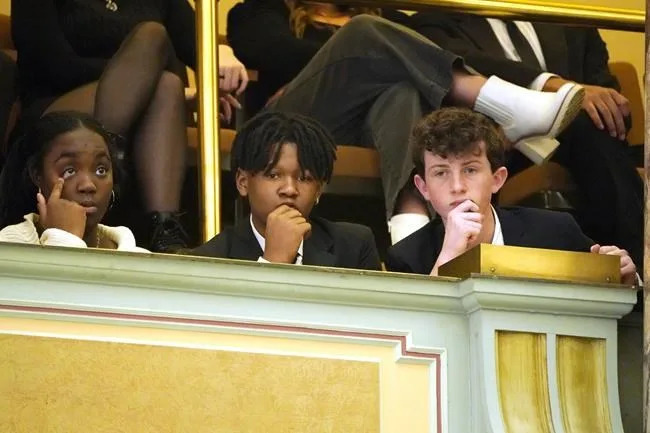
JACKSON, Miss. (AP) — Jackson’s troubled water system could be one step closer to getting new owners after legislation passed the state Senate Tuesday.
It's the latest development in a crisis that has left residents of Mississippi's capital without consistent access to running water and has aggravated divisions between the Democratic-led city and the Republican-controlled state government.
The bill would transfer ownership of Jackson's water system to a new regional public entity overseen by a nine-member board — with the majority appointed by state leaders. Sponsored by Republican Sen. David Parker of Olive Branch, it passed in a 34-15 vote and will move to the House for more work.
Parker said he introduced the bill to establish how the water system will be governed after Ted Henifin, the system's interim manager appointed by a federal court, concludes his work. Parker also said Jackson's water woes are stymying economic development.
“This crisis has been a black eye on the city of Jackson. But it's also been a problem for the state as a whole,” Parker said.
Parker recounted an incident where a German company was considering expanding to Mississippi. The company asked if the state had running water.
The water crisis has caused repeated outages in which many of the city's 150,000 residents have gone days and weeks without water to drink, cook, bathe or flush toilets.
Democratic senators rebuked the move as a brazen seizure of a city asset and overreach by the state government into Jackson's affairs.
“If we’re so concerned about our national reputation, are you aware of how we look right now?” said Sen. John Horhn, a Democrat from Jackson. “Mississippi looks like the old Mississippi that we heard about and some of us have lived through. We look like we are doing a taking on some Black folks.”
Jackson is an 80% Black city. Jackson Mayor Chokwe Antar Lumumba is Black, as are most of the lawmakers who represent the city in the state legislature. Lumumba has said he wants the city to maintain control of its water.
Under the bill’s original version, the Jackson mayor would have four appointments to the regional utility. On two of those, the mayor would have been required to “consult” with the mayors of suburban Byram and Ridgeland. The governor would make three appointments, and the lieutenant governor would make two. All nine would need to be confirmed by the Republican-controlled state Senate.
Parker brought a modified version of the bill to the Senate Tuesday, which he said was the product of a meeting with Lumumba. Under the new version the Senate approved, the mayor would not have to consult with the mayors of the smaller cities.
“This is not a problem that the current mayor of Jackson created, that he had had any control over," Parker said. “We have been given an opportunity with some federal dollars to try to fix this problem.”
Henifin has said that he believed Parker's proposal to create a new regional entity was motivated by a desire by state officials to access a large pot of federal dollars earmarked for the Jackson. Since then, Parker added language to the bill stating that all federal funds should be used within the areas served by Jackson's water system.
Parker said he has not met with Henifin, but they have a meeting scheduled later this month. The new version of Parker’s bill also specifies the regional board would be a “corporate nonprofit” — the model favored by Henifin.
Parker’s district is in northwest Mississippi, but he lives with his daughter at an apartment complex in Jackson when the Legislature is in session. He said scooping up water from the building’s swimming pool to use in their shared apartment’s toilets is part of what prompted him to introduce the bill.
The Republican-controlled House voted 83-28 Tuesday to pass legislation that says cities must base water bills on the amount of water a customer uses, prohibiting water billing based on the home’s value. The bill would outlaw a new billing system proposed by Henifin earlier this month. Lumumba watched the debate from a public gallery with other spectators.
___
Michael Goldberg is a corps member for the Associated Press/Report for America Statehouse News Initiative. Report for America is a nonprofit national service program that places journalists in local newsrooms to report on undercovered issues. Follow him on Twitter at twitter.com/mikergoldberg.
Michael Goldberg, The Associated Press
Court says South Korea responsible for Vietnam War massacre
Tue, February 7, 2023
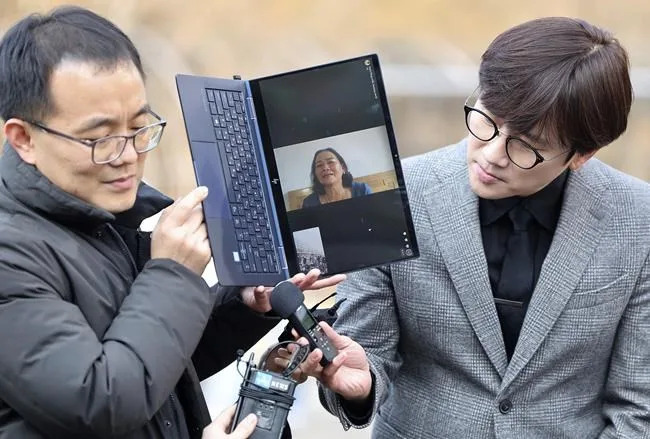
SEOUL, South Korea (AP) — A South Korean court on Tuesday ordered the government to pay 30 million won ($24,000) to a Vietnamese woman who survived a gunshot wound but lost several relatives when South Korean marines rampaged through her village during the Vietnam War in 1968.
In awarding the compensation to 62-year-old Nguyen Thi Thanh, the Seoul Central District Court dismissed the government’s argument that it was unclear whether South Korean troops were responsible for the slaughter in the village of Phong Nhi in central Vietnam.
The court also rejected the government’s argument that civilian killings were unavoidable because the South Korean troops were dealing with Viet Cong guerrillas who often blended with villagers, according to Thanh’s lawyer, Lim Jae-sung. The government’s lawyers were also unsuccessful in invoking a statute of limitations.
The ruling marks the first time a South Korean court has found the government responsible for mass killings of Vietnamese civilians during the war and could potentially open the way for similar lawsuits. Then ruled by anti-communist military leaders, South Korea sent more than 320,000 troops to Vietnam, the largest foreign contingent fighting alongside U.S. troops.
South Korea’s Justice Ministry didn’t immediately respond to a query whether the government will appeal.
The government has never officially acknowledged responsibility for civilian massacres linked to South Korean soldiers in Vietnam, which some experts say were possibly responsible for thousands of deaths. Those atrocities haven’t meaningfully impacted official relations with Vietnam, whose growing economy benefits from South Korean investment.
According to U.S. military documents and survivors, more than 70 people were killed and around 20 others injured when South Korean marines allegedly fired at unarmed civilians as they swept through Phong Nhi and the nearby village of Phong Nhut on Feb. 12, 1968. The action came after least one South Korean soldier got struck and injured by nearby enemy fire.
Thanh, then 7 years old, was treated for gunshot wounds in her stomach while five of her family members died, including her mother, sister and brother.
According to U.S. military investigation records, U.S. Marines and South Vietnamese militia provided medical treatment to villagers who fled as South Korean soldiers continued to shoot inside the villages.
U.S. Marines later entered the villages and found piles of bodies in different areas, many burned or buried in ash. One U.S. soldier took photos which were used as evidence during Thanh’s trial.
Thanh filed the lawsuit against the South Korean government in 2020 and testified at the Seoul court last August. The trial also included the testimonies of other Vietnamese villagers and South Korean war veterans such as Ryu Jin-seong, a member of the marine unit linked to the attacks in Phong Nhi and Phong Nhut. He provided a first-hand account of how the South Korean soldiers shot at unarmed civilians, many of them children and women.
Thanh, who awaited the ruling in Vietnam, said she was “overjoyed” by her court victory.
“I think that the souls (of those who died in Phong Nhi) were always with me and supported me,” she said in a video message translated by her legal team. “I am overjoyed because I think that the souls can now rest easy.”
The South Korean government had argued there was no conclusive evidence that South Korean troops were responsible for the killings, even suggesting that the aggressors may have been Viet Cong fighters disguised in South Korean uniforms who were attempting psychological warfare.
The government also insisted that even if South Korean soldiers were involved, their aggressive response was defensible because they were facing constant threats from Viet Cong guerrillas who often hid among villagers and actively recruited young women.
Thanh’s lawyers pushed back at the claim, saying there was no way to justify the killings when South Korean veterans have consistently said they didn’t face any meaningful resistance or aggression from the villagers, who were rounded up and shot from close range.
Kim Tong-hyung, The Associated Press
Court denies aid for Hiroshima A-bomb survivors' children
Tue, February 7, 2023
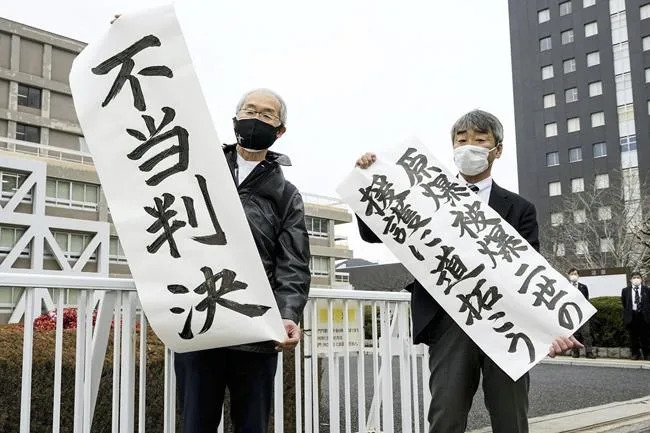
TOKYO (AP) — A Japanese court on Tuesday rejected a damage suit filed by a group of children of Hiroshima atomic bombing survivors seeking government support for medical costs, saying the hereditary impact of radiation exposure is still unknown.
A group of 28 plaintiffs whose parents suffered radiation exposure in the Aug. 6, 1945, U.S. atomic attack were demanding the central government include them in the medical support available to survivors.
The Hiroshima District Court said the possibility of a hereditary effect from radiation cannot be denied, but there is no established scientific consensus and the government’s exclusion of the plaintiffs from medical support is not unconstitutional.
The government has insisted there is no scientific evidence showing a hereditary effect from parents’ radiation exposure on their children.
The plaintiffs filed a lawsuit in 2017 seeking 100,000 yen ($760) each from the government in damages, saying their exclusion violated the constitutional right to equality.
A similar lawsuit by their peers in Nagasaki was also rejected in December.
The plaintiffs said they plan to appeal Tuesday's decision, which they called “unjust."
“It was an extremely cold ruling,” plaintiff Taku Kakuda told reporters. “It was as if we were told to prove the radiation impact on humans with our bodies.”
The atomic bombing of Hiroshima destroyed the city and killed 140,000 people. The United States dropped a second bomb three days later on Nagasaki, killing another 70,000. Japan surrendered on Aug. 15, 1945, ending World War II and its nearly half-century of aggression in Asia.
Many survivors of the bombings have lasting injuries and illnesses resulting from the explosions and radiation exposure and have faced discrimination in Japan.
Their children, known as “hibaku nisei,” or second-generation survivors of atomic bombs, say they constantly worry about the possible hereditary effects of radiation from their parents’ exposure, and many have developed various forms of cancer and other health problems. They estimate their numbers at 300,000 to 500,000.
Currently, only survivors and those with prenatal exposure who were certified can receive government medical support for their radiation illnesses and cancer checkups. The government started providing free medical checks for their children in 1979 but cancer examinations are not included.
“We understand that the court acknowledged our argument,” Chief Cabinet Secretary Hirokazu Matsuno said of Tuesday's ruling.
Mari Yamaguchi, The Associated Press
LGBTQ groups demand Japan adopt equal rights law by G-7
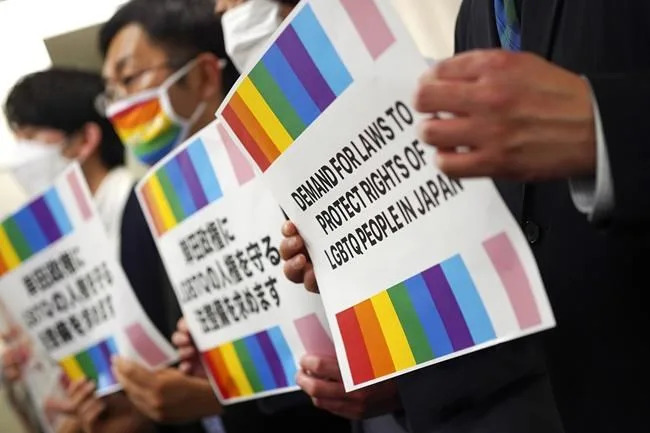
TOKYO (AP) — Japanese LGBTQ people and rights groups condemned a recent discriminatory remark by a senior aide of Prime Minister Fumio Kishida, demanding his government enact laws to ban discrimination against sexual minorities, legalize same-sex marriage and guarantee equal rights before Japan hosts a Group of Seven summit in May.
Their comments at a news conference Tuesday followed remarks last week by Kishida aide Masayoshi Arai, who was fired after telling reporters he wouldn't want to live next to LGBTQ people and that citizens would flee Japan if same-sex marriage was allowed.
Despite Kishida's quick dismissal of Arai, a comment the prime minister made earlier last week raised questions about his intentions toward sexual minorities.
Responding to an opposition lawmaker’s question in parliament, Kishida said whether to allow same-sex marriage is “an issue that must be examined extremely carefully.” A decision requires a thorough examination of all of society “because the issue may change the concept of family and values as well as society," he said.
At Tuesday's news conference, LGBTQ activists and their supporters said while Arai's remarks displayed outright prejudice against sexual minorities, Kishida's equivocal comments suggested his reluctance to tackle the issue despite his earlier pledge to create an inclusive and diverse society.
“Discriminatory remarks by the prime minister's aide made it clear to the rest of the world that Japan is a country that does not care about the rights of sexual minorities," said Takako Uesugi, a lawyer and director of Marriage For All Japan, an organization campaigning for legalization of same-sex marriage.
Noting that Japan is the only member of the Group of Seven advanced industrialized nations that lacks a law protecting the rights of sexual minorities, she said, “We must say Japan is not fit to lead the G-7 summit if we leave the situation unaddressed."
They demanded the government immediately begin the process of legalizing same-sex marriage, establish a working team to study ways to guarantee the rights of sexual minorities, appoint an aide to the prime minister who specializes in sexual minorities' rights, and include statistics of same-sex couples in the national census.
Support for sexual diversity has grown slowly in Japan and legal protections are still lacking for lesbian, gay, bisexual and transgender people. They often face discrimination at school, work and at home, causing many to hide their sexual identities.
In recent years, more than 200 local municipalities, including Tokyo, have introduced certificates of partnerships for same-sex couples allowing them to rent apartments and sign documents in medical emergencies, and for inheritance. Still, the certificates are not legally binding and same-sex couples are often barred from visiting each other in the hospital and from getting access to other services available to married couples.
Campaigns for equal rights for sexual minorities have faced resistance from conservatives in Prime Minister Fumio Kishida’s governing Liberal Democratic Party. An attempt to enact an equality awareness promotion law ahead of the 2021 Tokyo Olympics was quashed by the party.
Amid national outrage over Arai's remarks, the party's secretary general, Toshimitsu Motegi, said he planned to start preparing for legislation to promote awareness of LGBTQ rights, but some conservatives have already shown resistance. A group of non-partisan lawmakers also said they hope to enact an equality law by the G-7 summit.
The activists noted Japan signed the G-7 Elmau summit communique in June which calls for “full, equal and meaningful participation of women and girls in all their diversity as well as LGBTIQ+ persons in politics, economics, education and all other spheres of society.”
“Kishida's lack of effort to establish legal protection is tantamount to promoting discrimination,” said Soshi Matsuoka, an activist who launched an online petition for laws promoting anti-discrimination and equality rights that has received more than 40,000 signatures since Sunday.
Tue, February 7, 2023
Stories of the Land explores human connections with natural world
Tue, February 7, 2023
Indigenous, scientific and artistic connections to the land converged in a cultural learning circle at artsPlace last week, sparking meaningful discussion about the future of the planet and our role in caring for it.
Stories of the Land provided a unique opportunity for cross- culture and disciplinary collaboration between Îyârhe (Stoney) Nakoda First Nation members, Bow Valley-based scientists and environmentalists, and the arts community. The event explored the history, diverse perspectives and knowledge systems surrounding peoples’ connection to the earth, as well as the importance of working together as a force for good toward conservation.
“We have to coexist with each other as people, those who came from across the pond and within our own Nations as well,” said Îyârhe Nakoda member Travis Rider and Indigenous liaison at artsPlace. “We also need to learn how to better coexist with the four-legged and live in harmony with nature.”
Rider was joined by Cory Beaver, Terry and Margaret Rider and others who spoke of traditional knowledge and the spiritual significance of the land to Îyârhe Nakoda First Nation, emphasizing the reciprocal relationship between Indigenous people and the earth, as well as the responsibility to care for and protect the land for future generations.
“Part of being able to coexist is understanding what that word means to Indigenous peoples,” said Rider. “We’re talking about the land, the animals. … We also have to keep in mind our children and grandchildren.
“You have to look down your family line and what you see [in nature] is what they also have to see.”
For Beaver, understanding the land, the way the ecosystem functions and the issues it faces is inherent to feeling connected to it. Beaver’s ancestors were some of the original stewards of the environment surrounding Chuwapchîchiyan Kudebi (Canmore). They followed animal migration patterns, controlled wildlife populations through hunting, and tracked weather systems to camp and navigate within the landscape before having their movements restricted by reservations.
“The way those that came before us understood these things, it was all interconnected through the way a plant grows, the way the trees stand and the river flows,” said Beaver.
While some park conservation plans are changing to now include Indigenous consultation – including Banff National Park – colonial ways of thinking have taken over conservation efforts following the introduction of national and provincial parks across Canada.
Over the last 30 years, ecologist John Paczkowski has observed many changes in wildlife populations and behaviours as a large predator expert in the Bow Valley.
“I remember coming here and it was a lot more common to see wolves around Canmore and the kills they were making,” said Paczkowski. “We had collared wolves and were tracking them, and they’re quite a rarity now coming through Canmore.
“It’s sort of heartbreaking.”
Cooler temperatures throughout the Bow Valley late into last year’s spring season led to crops of fewer berries, resulting in bears seeking out other sources of food in town, including garbage.
“They were interacting more with people and getting into trouble,” said Paczkowski. “It makes you reflect on the impacts that we’re having on the landscape here, whether it’s fire suppression or just taking up more of that habitat.
“Over the years I’ve been able to see that change and what it means to the bears and how they behave, how they react.”
Last year, a mamma black bear and her three cubs were relocated to an area west of Caroline in mid-September after they bolted into a downtown Canmore restaurant and accessed bags of brown sugar.
The bears were eventually euthanized when the sow and two of her cubs returned to Canmore by early October, where they were reported to have been feasting on garbage in a downtown dumpster and sleeping in backyards over a period of several nights. The third cub was believed to have died on the difficult and lengthy journey back to town.
The circle discussion, which was organized in partnership between artsPlace, the Banff Canmore Community Foundation (BCCF) and the Biosphere Institute of the Bow Valley, stressed the need for collaboration between traditional knowledge and science to make informed decisions about the future of the environment if humans are to coexist with wildlife while going a step further allowing native species to flourish.
“I would wish that in 200, 300, or 400 years, that there’s still bears moving through this valley and that there will still be an ecosystem that functions to support the natural world as I know it now, or maybe as it was in the past,” said Paczkowski. “An ecosystem that’s not just hanging on by its claws, but flourishing.”
As discussions continued into the evening, artist Laurelle Birk encouraged attendees to step into the circle and add various harvested elements, including pinecones, grasses, berries and branches to a land-based mandala design growing on the floor.
The mandala, separated into four quadrants, not unlike many Indigenous representations of a medicine wheel, was a powerful visual representation of some of the deep connections humans have with the natural world and the need for a relationship which achieves balance and harmony.
The event was seeded in the collaborative work of Moving Mountains, a BCCF initiative in partnership with the Town of Canmore and the Town of Banff that is taking a regional, Bow Valley-wide approach to strengthening civil society across communities in the region.
Moving Mountains is hoping to host the same session in Mînî Thnî (Morley) and out on the land in Kananaskis Country in upcoming months. For more information, visit banffcamorecf.org/programs-events/moving-mountains.
Jessica Lee, Local Journalism Initiative Reporter, Rocky Mountain Outlook
National reconciliation day to become September statutory holiday in B.C.
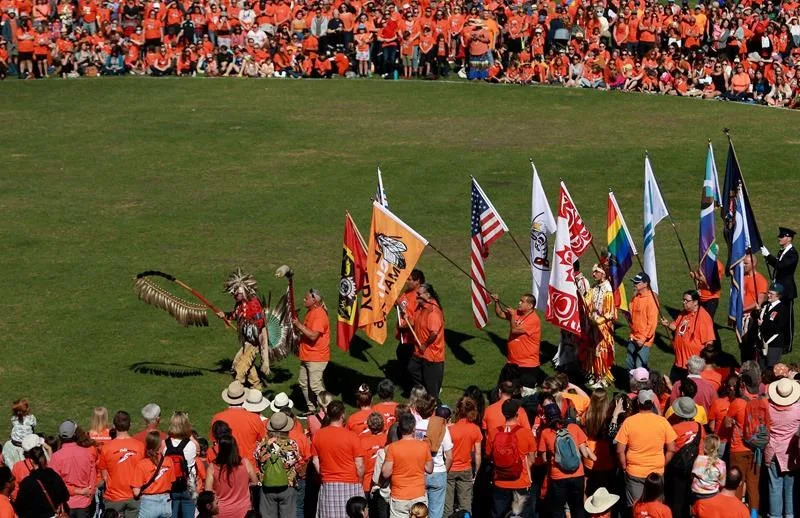
VICTORIA — The British Columbia government introduced legislation Tuesday to make Sept. 30 a statutory holiday to mark the National Day for Truth and Reconciliation, a recognition that Labour Minister Harry Bains said will provide opportunities to hold annual commemoration events similar to Remembrance Day.
Bains introduced a bill in the legislature, saying the holiday will be observed this year and every Sept. 30 afterwards.
The B.C. holiday follows the federal government's decision in 2021 to declare Sept. 30 a national truth and reconciliation holiday for its workers.
"I'm proud and humbled to be part of what I consider a historic step as a British Columbian," said Bains at a news conference following the introduction of the National Day for Truth and Reconciliation Act.
"This day provides an annual opportunity for people to learn about our colonial history and how it has impacted Indigenous communities, and to participate in commemorative events in a way similar to Remembrance Day," he said.
Those ceremonies are held across Canada every Nov. 11 to honour the sacrifices of the casualties of war and military members who serve the country.
"Reconciliation is about each and every one of us," Bains said. "All British Columbians and Canadians have a role to play. This new statutory holiday in B.C. will allow more people to get involved in advancing reconciliation."
He said all workers in B.C. will be covered by the province's Employment Standards Act and will be entitled to a paid day off every Sept. 30.
Prior to the introduction of the act, business, labour, Indigenous and social groups were consulted about a new statutory holiday, Bains said.
Bains told the legislature the government's decision on the holiday is in response to the Truth and Reconciliation Commission’s call to action No. 80, which requested the federal government establish a holiday to honour residential school survivors, their families and communities.
B.C. will join Prince Edward Island, the Northwest Territories, Nunavut, Yukon and Canada as jurisdictions that have already designated Sept. 30 as a statutory holiday, if the legislation passes. New Brunswick has made the day a provincial holiday but says it's optional for the private sector.
Murray Rankin, B.C.'s Indigenous relations and reconciliation minister, said the holiday will provide opportunities for people to understand and reflect on a time in Canada's history when children were forced to attend schools that stripped them of their culture and caused emotional and physical harm.
"I can say we will all recall the shock, the sadness, the anger that followed the findings at the Kamloops residential school," he said. "Many Indigenous children suffered physical, emotional, psychological and sexual abuse at these institutions, and sadly many Indigenous children died at them."
Chief Rosanne Casimir of the Tk’emlups te Secwepemc First Nation reported in May 2021 the discovery by ground-penetrating radar of what were believed to be possible remains of more than 200 children at the site of the former Kamloops Indian Residential School.
Similar reports of possible remains at residential school sites at former institutions across Canada have been made since the Kamloops discovery.
The Kamloops residential school operated between 1890 and 1969, when the federal government took over operations from the Catholic Church and ran it as a day school until it closed in 1978.
A 4,000-page report by the National Truth and Reconciliation Commission released in 2015 detailed harsh mistreatment at the schools, including emotional, physical and sexual abuse of children, and at least 4,100 deaths at the institutions.
The report cited records of at least 51 children dying at the Kamloops school between 1914 and 1963. Health officials in 1918 believed children at the school were not being adequately fed, leading to malnutrition, the report noted.
"This is the heavy truth of our history that we must confront as British Columbians and as Canadians," Rankin said. "Reconciliation is a process of healing relationships. It requires public truth telling, apology, commemoration that acknowledges and seeks to address past harms."
He said B.C. has a responsibility to remember the children who never came home and honour residential school survivors.
Phyllis Webstad said she was "humbled and honoured" that her Orange Shirt Day campaigns have become part of the Sept. 30 National Day for Truth and Reconciliation.
Webstad started wearing an orange shirt on Sept. 30 to mark her first day of school as a child. She said residential school administrators took away her clothes, including her new orange shirt.
She said the statutory holiday ensures people no longer have an excuse "to not know what happened to us."
Premier David Eby says his government is taking the important step to enshrine the day in law to acknowledge the wrongdoings of the past, and to take meaningful action toward reconciliation.
"Many British Columbians have been marking Orange Shirt Day with humility, respect and reflection in their own way for years," says Eby in a statement, referring to a day that honours survivors and those who didn't return from residential schools.
Grand Chief Stewart Phillip, the president of the Union of B.C. Indian Chiefs, says the day of reconciliation is welcome.
"For this day to be truly meaningful, it requires healing and capacity for change," Phillip says in a statement.
This report by The Canadian Press was first published Feb. 7, 2023.
Dirk Meissner, The Canadian Press
Explainer-What ails Canada's healthcare system?
Anna Mehler Paperny
Tue, February 7, 2023

FILE PHOTO: Humber River Hospital in Toronto
By Anna Mehler Paperny
(Reuters) - Canada's provincial and federal leaders were slated to meet on Tuesday in an attempt to agree upon potential solutions to bolster the country's stretched public healthcare system. Long a source of pride, Canada's publicly funded healthcare system has been strained to the breaking point due to factors including the pandemic and staffing shortages.
Here are some of the issues facing Canada's health system:
WHAT ARE THE MAIN CHALLENGES?
A shortage of healthcare workers fueled in part by burnout and attrition has plagued Canada's hospitals, clinics and primary care resources. The health and social services sector vacancy rate was 5.7% in November, down from a multi-year high of 6.6% two months earlier.
According to the Canadian Institute for Health Information there were 93,998 physicians in Canada in 2021, or 2.46 per 1,000 people.
According to the World Bank using World Health Organization statistics, the United States had 2.6 physicians per 1,000 people in 2018 and the United Kingdom had 5.8 in 2019.
WHERE ARE THE PRESSURE POINTS?
The crisis is most evident in the country's hospitals, which faced a surge in respiratory illnesses last fall that left some people waiting hours in emergency departments, sometimes being treated there because of a lack of staffed beds. There were high-profile deaths of people whose families said they could have lived had they received timely care.
WHAT IS THE PRIMARY CARE CONUNDRUM?
Primary care providers are considered the "front door" of healthcare - they are the clinicians who follow patients, deal with a range of concerns and determine who needs a specialist's care. But millions of Canadians do not have one. A survey conducted last fall found 22% of respondents lacked a family doctor or nurse practitioner they could talk to about their health. Lacking a primary care provider can mean problems do not get caught early or people rely on walk-in clinics or emergency rooms.
WHAT ROLE DOES AN AGING POPULATION PLAY?
Canada has failed to address the growing healthcare needs of an aging population, said Alan Drummond, an emergency physician at the Great War Memorial Hospital in Perth, Ontario.
On any given day, a fifth of hospital beds in Ontario are taken up by people who do not need to be hospitalized, Drummond said. They are often awaiting transfer to a long-term care facility or to their home where they are assisted by a caregiver. But there are not enough home care or long-term care resources to provide for them, Drummond said.
WHAT DOES CANADA SPEND ON HEALTHCARE?
Total health spending in Canada was expected to reach C$331 billion in 2022, or C$8,563 per Canadian, according to the Canadian Institute for Health Information.
Total health expenditure in 2022 was expected to rise by 0.8%, following a high growth rate of 13.2% in 2020 and 7.6% in 2021. From 2015 to 2019 health spending growth averaged 4% per year.
In 2022 total health spending was 12.2% of GDP, down from 13.8% in 2020. According to the Organisation for Economic Co-operation and Development, Canada's per-capita health spending was below that of the United States, Germany, Switzerland and other rich countries in 2021.
WHAT DO THE PROVINCES WANT?
The provinces have asked for billions more in funding from the federal government. Ottawa, for its part, has said such a funding boost must come with strings attached. This could include improvements in data collection and the provision of mental health care, among other things. The federal government and the provinces have cautioned not to expect finalized deals on Tuesday.
(Reporting by Anna Mehler Paperny in Toronto; Editing by Matthew Lewis)
Canada pledges C$46.2 billion in new funding to fix strained healthcare system
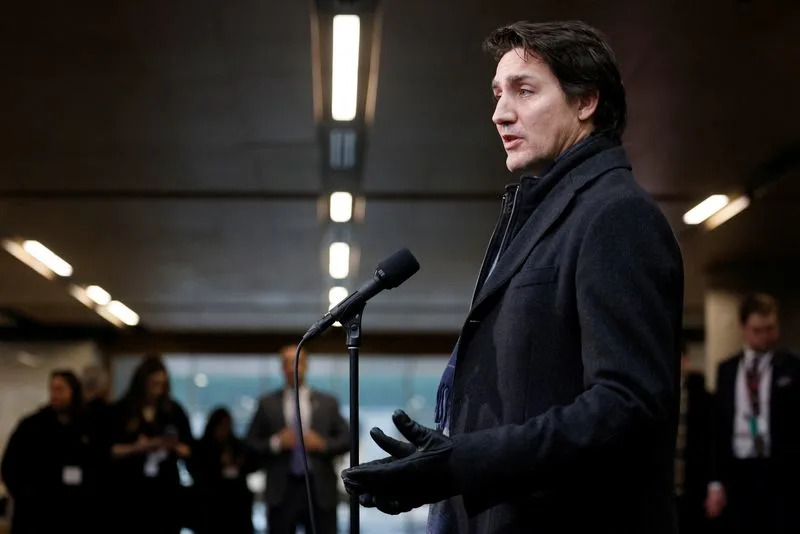
Tue, February 7, 2023
By Ismail Shakil and Anna Mehler Paperny
OTTAWA/TORONTO (Reuters) -Canada's federal government will provide an additional C$46.2 billion ($34.4 billion) in new funding for the country's public healthcare system over 10 years, it said on Tuesday following a meeting with its provincial and territorial counterparts to hammer out a deal to fix the overburdened system.
Canada's public healthcare systems have been under strain thanks in part to the pandemic and staffing shortages that have left hospitals stretched to the breaking point.
For years the provincial governments, which are responsible for healthcare delivery, have asked Ottawa to increase its contribution to health spending. The federal government, for its part, said it wanted new money to come with conditions.
Provincial premiers told reporters they had to digest the proposal but were underwhelmed by the dollar amount. Manitoba Premier Heather Stefanson said they were "a little disappointed."
"What we see this as, is a starting point. It's a down payment on further discussion," said Ontario Premier Doug Ford.
Long a source of pride, Canada's publicly funded healthcare system has been strained by the pandemic and staff shortages.
Some of the new funds promised Tuesday are unconditional; others are earmarked for certain priority areas. The federal government is asking the provinces to commit to better data gathering and sharing in order to access the increased funds.
But the proposal, which seeks to use bilateral agreements to target priority areas such as primary care and mental health, suggests the federal government has more ability to dictate health spending than they do, said Sara Allin, an assistant professor at the University of Toronto's Institute of Health Policy, Management and Evaluation.
"It just sounds so much more prescriptive than the federal government actually can be."
A cash infusion could help Canada's healthcare, Allin said. But the real problem is one of governance.
"How do we manage the system? How do we hold the different actors accountable?"
The additional C$46.2 billion in funding unveiled Tuesday is part of a larger C$196.1 billion package in increased health funding over a decade.
"Canadians deserve better health care and we need immediate actions to address current and future challenges," Health Minister Jean-Yves Duclos said in a statement.
The deal needs signoff from the provinces, which have previously pushed back against the federal government's conditions.
Tuesday's meeting in Ottawa could result in an agreement over a general outline of healthcare funding, but the federal government and the provinces have cautioned not to expect finalized deals on Tuesday.
Tuesday's package includes C$25 billion over 10 years to be hammered out in bilateral agreements to target shared health priorities in the fields of family health services, healthcare workers and backlogs, mental health and substance use, and "a modernized healthcare system."
The Canada Health Act governs the country's publicly funded healthcare system, which is meant to offer Canadians equitable access to medical care based on their needs, not their ability to pay.
($1 = 1.3414 Canadian dollars)
(Reporting by Steve Scherer and Ismail Shakil in Ottawa and Anna Mehler Paperny in Toronto; Editing by Sandra Maler, Aurora Ellis and Jonathan Oatis)
Factbox-Details on Canadian government new healthcare funding
Tue, February 7, 2023
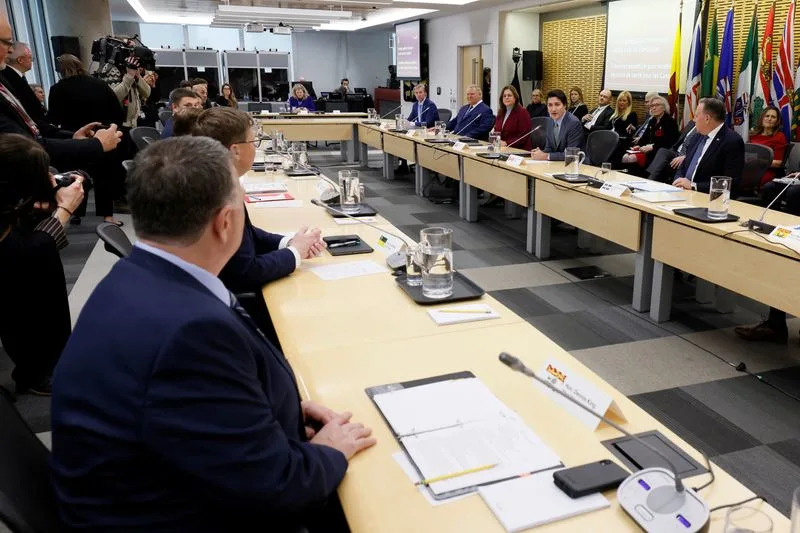
Provincial and Territorial premiers gather to discuss healthcare in Ottawa
TORONTO (Reuters) - The Canadian government on Tuesday announced C$46.2 billion ($34.4 billion) in new funding for provinces and territories to tackle the country's strained public health system.
Here are some of the key aspects of the plan:
* An immediate C$2 billion Canada Health Transfer (CHT) to
address pressures on the healthcare system, especially in pediatric hospitals and emergency rooms, and long wait times for surgeries.
* A 5% CHT guarantee for the next five years, which will be provided through annual top-up payments as required.
* C$25 billion over 10 years to advance shared health priorities through tailored bilateral agreements that will support the needs of people in each province and territory in four areas of shared priority: family health services; health workers and backlogs; mental health and substance use; and a modernized health system.
* These additional federal investments will be contingent on continued healthcare investments by provinces and territories.
* C$1.7 billion over five years to support hourly wage increases for personal support workers and related professions, as federal, provincial, and territorial governments work together on how best to support recruitment and retention.
* C$2 billion over 10 years to address the unique challenges indigenous peoples face when it comes to fair and equitable access to quality and culturally safe healthcare services.
($1 = 1.3414 Canadian dollars)
(Compiled by Denny Thomas; Editing by Bill Berkrot)
SEIU HEALTHCARE RESPONSE TO NEW FEDERAL FUNDING FOR PERSONAL SUPPORT WORKERS
RICHMOND HILL, ON, Feb. 7, 2023 /CNW/ - The following statement can be attributed to SEIU Healthcare president, Sharleen Stewart:

Canada's Healthcare Union (CNW Group/SEIU Healthcare)
"SEIU Healthcare welcomes the federal government's commitment today of $1.709 billion to invest in personal support workers (PSWs) and care workers like them who support our vulnerable loved ones.
This funding marks a giant step forward towards achieving a $25 per hour national minimum wage for all PSWs across Canada.
Our message to provincial and territorial governments is simple: the time for excuses is over—it's time to raise wages for PSWs and provide better healthcare jobs—it's time for $25 for Canada's PSWs and all underpaid healthcare workers like them.
We call on Canada's premiers to accept this money and raise wages for healthcare workers immediately because good healthcare jobs mean better care for seniors and patients.
Canada's health human resources are in crisis and workers on the frontline are demanding that all governments invest in safe staffing levels. That's why SEIU Healthcare will never stop fighting for all healthcare workers who are overworked and underpaid, and with action from all levels of government we can end the exploitation of women in the care economy more broadly, and all healthcare workers in particular."
SEIU Healthcare represents more than 60,000 healthcare and community service workers across Ontario. The union's members work in hospitals, homecare, nursing and retirement homes, and community services throughout the province. www.seiuhealthcare.ca
SOURCE SEIU Healthcare
View original content to download multimedia: http://www.newswire.ca/en/releases/archive/February2023/07/c6390.html
Controversial Calgary Lecturer Shut Down At University Of Lethbridge
Tue, February 7, 2023
(ANNews) – Hundreds of University of Lethbridge students protested a scheduled talk from a former Mount Royal University (MRU) professor who has engaged in residential school denialism. The talk was cancelled as a result of the protest.
Frances Widdowson, who has said residential school survivors received an education “normally they wouldn’t have received” and that the Black Lives Matter movement “destroyed” MRU’s campus was fired from her role as an economics, justice and policy studies professor last year.
While Widdowson claimed she was disciplined for “criticizing ‘woke’ ideas,” the university issued a statement saying academic freedom “does not justify harassment or discrimination.”
The protests against Widdowson’s appearance at U of L were led by Indigenous students and faculty, with allies joining them in support.
Some protestors surrounded Widdowson and shouted her down while others chanted and played guitar. A drumming circle also formed, with community members dancing in the hall.
“Every time Widdowson was forced to move further away from the atrium, loud applause and cheering erupted in the crowd,” Stephen Hunt reported for CTV News, adding that a “handful of people” were there to support her.
She was ultimately whisked away from campus by security and was scheduled to deliver her talk over Zoom.
Keely Wadsworth, a fourth year Aboriginal Health student, told CTV she “100 per cent support[s] cancelling” Widdowson’s lecture.
Wadsworth spent last summer researching and detailing incidents that took place on six residential schools on the Blood Reserve.
“I know every single incident, I know every single death that happened,” she said,” How do you take all that knowledge and think that it’s positive?”
Brittany Lee, a councillor with Lethbridge Metis Local 2003 said she was there to support the more than 2,000 Metis people who live in the Lethbridge area.
“We believe that education should be the means to repairing the damage that was done to our peoples via the residential school system, and not a means to rehash some of the tragic events that have happened in the past. So we’re here to rebuild that relationship and make sure that everybody’s feeling supported in that way,” she said.
After the event’s cancellation, U of L president Mike Mahon issued a statement expressing his “sincere appreciation to our community members for conducting themselves in such a peaceful and powerful manner.”
In an interview with the Lethbridge Herald, Widdowson said she places blame “squarely at the feet of the university’s president for not cultivating an environment for intellectual discussion, open inquiry and academic freedom.”
The Widdowson incident highlighted tension between U of L’s commitment to academic freedom and its stated commitment to the Truth and Reconciliation Commission’s Calls to Action.
The university originally said it would provide space with her lecture in line with its free expression policy, but then backtracked based on its TRC commitments. Widdowson still showed up.
The cancellation of Widdowson’s lecture produced a backlash from the provincial government. Minister of Advanced Education Demetrios Nicolaides announced that universities will now be required to submit annual reports on their efforts to “protect free speech” on campus, and threatened further measures.
“It is abundantly clear that more needs to be done to ensure our institutions are adequately protecting free speech,” Nicolaides wrote.
The Canadian Association of University Teachers initially said the cancellation of Widdowson’s lecture raised ““serious concerns about the University of Lethbridge’s commitment to freedom of expression and academic freedom.”
But after the government announced its apparent reprisal, the association emphasized that the state “cannot and should not dictate how universities run their internal academic affairs.”
In response to the government’s announcement, the University of Calgary Students’ Union issued a statement in support of the U of L community “strongly standing against hate on their campus.”
“U of L students stood up, held firm, and made it clear that they had no interest in hearing a lecture that denies the genocidal nature of residential schools and the lasting harm these institutions have done to Indigenous peoples,” it said. “That decision should be respected.”
Former premier Jason Kenney forced all post-secondary institutions, except for Lacombe’s religious Burman University, to adopt free speech policies by December 2019 based on the so-called “Chicago principles,” which state community members “may not obstruct or otherwise interfere with the freedom of others to express views they reject or even loathe.”
Jeremy Appel, Local Journalism Initiative Reporter, Alberta Native News








